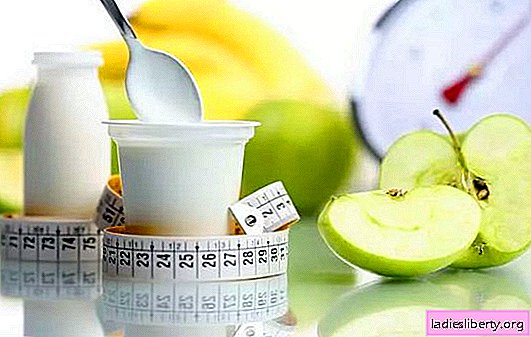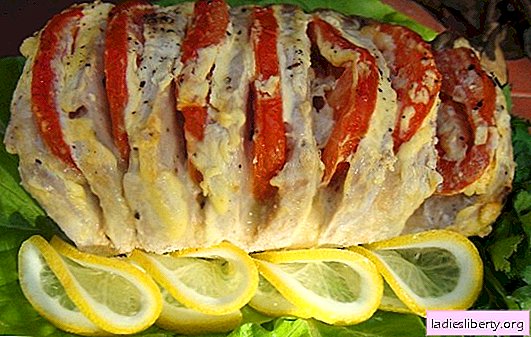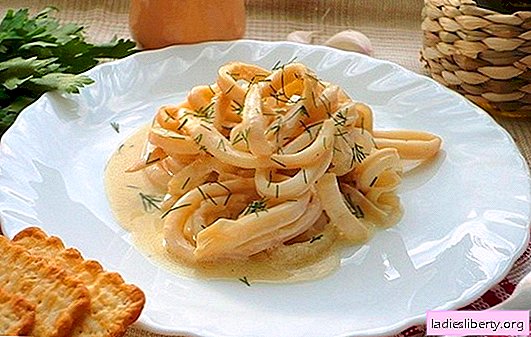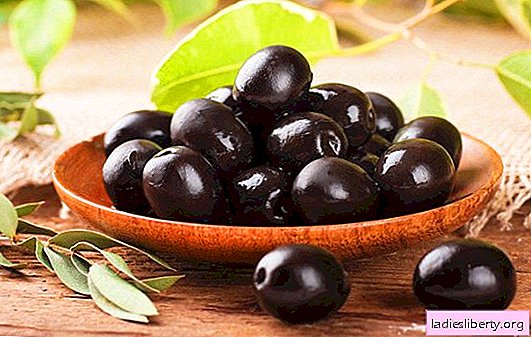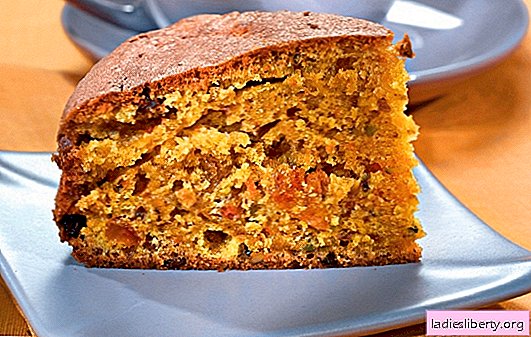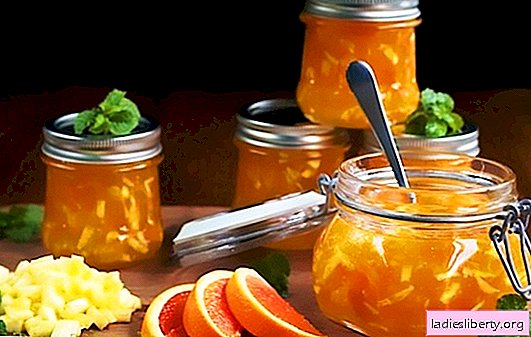
In English, there is the word "jam" - a fruit dessert made from whole and grated fruits with sugar.
But there is also the word "Varenye" in this language, which points to two facts at once - the old Russian desserts recipes were not only prepared using special technology, but were also very "respected", in their own way, unique sweets at the court of English monarchs, since the word "jam" entered the English language, as borrowed.
Jam-like fruit desserts are common in world cooking.
This is jam, candir, confiture, chutney, fig, kai.
If you meet these words on the Internet - we are talking about a variety of jam.
But only in the Russian version, this dessert is prepared using a special technology that is not characteristic of other national cuisines. Consider it as an example of apple and orange jam for the winter, the most common tropical citrus fruit and a truly "folk" fruit in temperate latitudes.
From the point of view of nutritional value, an orange and an apple are not inferior to each other in the content of vitamins, organic acids and minerals.
The combination of the juicy pulp of the “Chinese apple” (German Apfelsine) and the apple, with dense pulp, looks a bit unusual, but interesting - this contrast is very harmonious: the pronounced aroma of orange peel does not contradict the completely neutral apple taste.
Apple jam with orange for the winter - basic technological principles
A feature of Russian jam is the cooking method, in which the pieces of fruit retain their integrity, and the syrup, with any cooking method, must certainly maintain a transparent and stretching, thick consistency.
The ratio of fruit and syrup in the jam should be equal.
With such fruits as apples, it is not difficult to achieve a thick consistency, because they contain natural pectin - a thickener. Pectin is also present in oranges, but in smaller quantities. There is more pectin in the fruits of technical ripeness than in overripe fruits. This substance helps to maintain the integrity of the fruit during the cooking process, however, with prolonged heating, the pectin is destroyed. In this regard, jam cooking should take place in several stages, alternating by heating to 100 ° C for 5-10 minutes and completely cooling.
If it is necessary to make jam for their ripe fruit, then add 1 g of pectin per kilogram of prepared (peeled) fruit; It is usually sold in the spice department.
Thickening of jam also occurs due to the mass fraction of sugar, which in the syrup should be up to 60-65%. With this sugar content, jam is perfectly preserved without pasteurization. When adding sugar, the natural sugars contained in the fruits should be taken into account, because an excess of it can lead to sugaring of the product. But to determine the exact amount of sugar in certain fruits at home is possible only approximately organoleptically.
To avoid jamming the jam, add citric acid to the syrup when boiling it: when interacting with sugar in syrup, it partially (up to 40%) decomposes it into fructose and sucrose, helping to avoid not only sugaring the product, but also excessive consumption of carbohydrates. But it should also be borne in mind that the invert syrup formed by the addition of acid has the ability to evaporate moisture, which, accumulating under the lid, during storage causes fermentation of the product. Therefore, jam based on invert syrups or with the addition of molasses must be pasteurized and hermetically sealed jars.
There are several ways to make jam in home canning, but, frankly, some of the tricks have no rational explanation from a scientific point of view. To get high-quality jam, in which the fruits are not wrinkled, and the syrup is transparent, and all quality requirements are met 100%, you must understand that jam cooking is the diffusion of liquids with different densities.
That is, this happens as follows: dense and thick syrup when heated displaces the cellular juice of the fruit. But it must be borne in mind that at the boiling temperature of the juice (100 ° C) the juice prevents the penetration of syrup into the cells of the fetus. So, it is necessary that the syrup be hotter, and the juice boils later, after the syrup has replaced it in the cells, so that the fruits retain their shape. At the same time, the juice flows into the intercellular space and then into the syrup, outward, where it can be easily combined with the syrup, mixing the jam with a spatula. In order for the juice to boil later than the syrup, the fruits must be dipped in hot syrup. Then, due to the difference in temperature of the syrup and fruit, diffusion will be faster, which, in turn, will allow you to save more vitamins due to the reduction of the heat treatment time, at which the maximum loss of the most valuable substances occurs.
In order to successfully replace the juice in the fruits with sugar syrup, it is important to fully observe the technology, especially when it comes to apple jam with orange slices, in which the fruits initially have different densities. So, at a minimum, first you need to achieve a leveling density of oranges and apples.
There are several ways to do this:
Previously, before dipping in boiling syrup, blanch apples to reduce their density;
Start cooking jam by dipping apples, and after a while add slices of oranges to them;
Increase the density of oranges by boiling them with pectin, and then combine with apples.
There are many options, you just need to have a good idea of the jam cooking process from the inside, understand that each action leads to a certain result.
Recipe 1. Apple jam with orange for the winter
Composition:
Oranges 2.6 kg
Sugar 2 kg
Ranetki 3.0 kg
Vanilla
Cooking:
Trim the coarse parts of the stalk from the paradise apples and remove the stalk. Blanch them in boiling water for 7-10 minutes, put in a container with cold water, then dip in a colander and dry.
Remove the zest from the oranges, cut into strips and temporarily set aside. Peel the fruits of the skin and membrane film, fold the peeled pulp of oranges in a bowl for cooking jam. Sprinkle the orange pulp with sugar and bring to a boil.
Transfer apples to orange jam and cook for 5-10 minutes, 2-3 times. The jam should be brought to a boil, but do not let it boil. At the last cooking, add vanilla and zest, mix immediately, remove from heat and pack the jam in sterile and hot jars.
Recipe 2. Jam from apples with orange slices without sugar
Composition:
Water 300 ml
Honey, lime 700 g
Apples 1.5 kg
Oranges 1.2 kg
Cooking:
Wash and peel the fruit. Divide oranges (medium size) into slices. Remove the core from apples, do not cut the skin so that the sliced slices better retain their shape when cooking.
Melt the honey in boiling water, remove the foam. Boil the syrup until the volume is reduced by 1/3, then cool it to 80 ° C, immerse apple slices and cook, not letting it boil for up to 40 minutes. Add the orange slices, and after 5-7 minutes remove the jam from the heat.
When it cools down, put it in dry jars, tie with parchment paper and cover with a plastic cover on top. Store in a cool place.
Recipe 3. Apple jam with orange for the winter, from dried apples and figs
Composition:
Apple drying 1 kg
Figs 700 g
Orange juice 500 ml
Water 0.5 L
Sugar 1 kg
Pectin 1 sachet
Cooking:
Wash dried apples (slices) and boil with dried figs in 500 ml of water until the volume is doubled. Fold the fruit through a colander mounted on a jam pan. Dry the fruit a little, and in the meantime, pour sugar into the water in which it was boiled, mix until dissolved, add the orange juice and boil the syrup. Add pectin to the finished syrup, and after 2-3 minutes, immerse the dried fruits. Bring them to a boil, remove the foam and turn off the heat. After cooling, warm to a boil again and proceed to packing the jam.
Recipe 4. Apple jam with orange for the winter (quick way)
Composition:
Apples 1.0 kg (net)
Candied orange (cloves) 0.5 kg
Sugar 800 g
Water 300 ml
Citric Acid 50g
Cooking:
Cut the sorted, washed and peeled apples into slices of 8-10 parts (0.5-0.7 cm thick). Dissolve sugar and citric acid in boiling water, fill in apple slices and let cool. Apple slices should let the juice go. Then add candied fruit and cook for 10-15 minutes. Pack the jam hot, and start corking after cooling.
Recipe 5. Apple jam with an orange for the winter (with orange peels)
Composition:
Sugar 1.7 kg
Peel of oranges 500 g
Apples 1.5 kg
Water 500 ml
Vanilla
Cooking:
Peel the apples from the skin and seeds, cut into bars, also cut the peel of oranges. Temporarily immerse the prepared fruit mixture in a solution of citric acid. Cook thick syrup from water and sugar. Remove fruits from water and transfer to hot syrup. Cook in syrup 3-4 times, bringing to a boil and cooling. During the fourth cooking, add vanilla, turn off the stove and lay in hot and dry jars. When the jam cools, sprinkle the surface with sugar and cover.
Recipe 6. Apple jam with slices of orange and cranberries
Composition:
Cranberries 300 g
Sugar 1.3 kg
Candied orange (slices with skin) 500 g
Apples (with skin), winter 1 kg (net)
Water 400 ml
Cooking:
Take away the apples. It is better to use the "Renet Simirenko" variety, with dense and sweet pulp and green peel, which will look beautiful in syrup with orange pulp of oranges and red cranberry berries. Cut apples into slices with skin. Sort cranberries, wash, combine with apples and pour hot and thick syrup from sugar and water. Put the container on the fire and cook to a boil. Turn off the fire. After cooling, put candied orange in the jam, mix. Bring the jam again to a boil and pour 0.5 l into cans. Pasteurize hot cans for a couple of 10 minutes from the moment of boiling water in a pan. Roll up the lids and turn over.
Winter apple jam with orange - tips and tricks
Jam can be considered ready when the foam in the basin is collected in the middle.
To prevent mold from forming on the surface of the jam during storage, sprinkle it with a layer of sugar when the jam hardens. For the same purpose, cut mugs of parchment, according to the diameter of the jar, soak them in a strong saline solution and dry them before packing.
To save more vitamins in jam, try to cook it for a short time and immediately cork. Cooking time can be reduced by reducing the volume of fruits - the more fruits are cooked in a basin, the longer you have to wait until it boils, and the more vitamins disappear.

